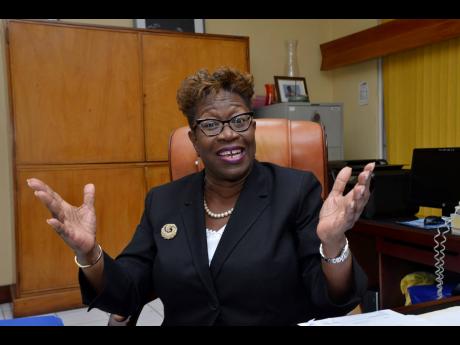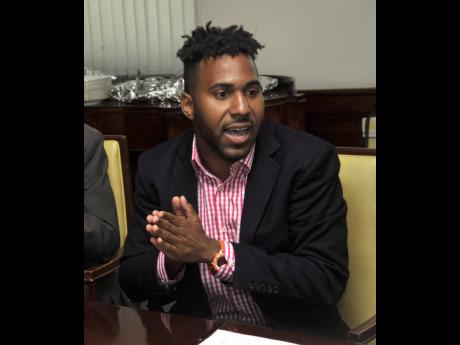DPP blames gang case stumbles on steep learning curve
There were some “misunderstandings” within Jamaica’s law-enforcement authorities about aspects of the so-called anti-gang legislation, the state’s top prosecutor has admitted. The Criminal Justice (Suppression of Criminal Organisations) Act became...
There were some “misunderstandings” within Jamaica’s law-enforcement authorities about aspects of the so-called anti-gang legislation, the state’s top prosecutor has admitted.
The Criminal Justice (Suppression of Criminal Organisations) Act became law in 2014, giving the police another tool to help crush criminal gangs blamed largely for the country’s high murder rate.
The Senate is expected to debate, and possibly approve, the revised legislation today.
There are approximately 379 criminal gangs operating in Jamaica, Minister of National Security Dr Horace Chang disclosed recently, citing the latest statistics from the Jamaica Constabulary Force (JCF).
Approximately 262 were considered active gangs, a five per cent increase over 2019, according to Chang.
Last year, 802, or 61 per cent, of the more than 1,300 murders recorded in Jamaica were classified as gang-related, JCF statistics reveal.
These gangs are financed mainly through contract killings, extortion, robberies, as well as drug and firearm trafficking, Chang noted.
But almost seven years after the legislation was enacted, prosecutors have had very little success putting accused gangsters in prison.
A total of 448 persons were arrested and charged for various breaches of the anti-gang law up to November 2018, but only two were convicted through guilty pleas.
Since then, Uchence Wilson and six members of his St Catherine-based syndicate have been convicted under the legislation.
Over the same three-year span, however, high-profile cases have collapsed against persons accused of being members of the Kings Valley Gang, based in Westmoreland, and the Burgher Gully Gang, based in east Kingston.
“We believe there were one or two misunderstandings in respect of some of the provisions of the anti-gang legislation,” Paula Llewellyn, director of public prosecutions (DPP), acknowledged, without making reference to any of the cases handled by her office.
Noting that the legislation is “fairly new”, Llewellyn said for the first three or four years, as with any other piece of legislation, law enforcers and prosecutors had to be like pioneers.
“When legislation is new and there is no case-law precedent in the Court of Appeal which explains or clarifies what may or may not be grey areas in the interpretation, you may have a flurry of cases which fall short in the final analysis, in respect of the ingredients [of an offence],” she told a Gleaner Editors’ Forum recently.
“So, you see the dilemma.”
Instead, Llewellyn indicated that in the first three years of the legislation, her office opted, in some instances, to prosecute accused gangsters for predicate offences identified as part of anti-gang cases.
“So, you may have an anti-gang offence, but you may also have had the person being charged for illegal possession of firearm, robbery with aggravation, or shooting with intent,” she said, explaining some of the predicate crimes that could be encapsulated in the anti-gang case.
“You put the best available evidence and match that to the easiest case that can be prosecuted where you have a reasonable prospect of conviction.”
One of the inherent challenges in prosecuting gangsters, according to Adley Duncan, deputy director of public prosecutions, is the kinds of witnesses prosecutors have to rely on to make their case.
“When you are talking about a gang, you not gonna get the Pope to be a witness, you not gonna get the pastor to be a witness, you not gonna get the schoolteacher to be a witness … . You gonna get somebody who was in the gang to be a witness,” he said.
“These persons don’t always make for the best kinds of witnesses. So, it’s not necessarily about the legal infrastructure or the funding that we put into getting these kinds of guys off the streets, it is the actual mechanics, the cogs in the wheels of a trial, that contribute to these outcomes.”
However, one top criminal-defence attorney has suggested that a misguided and discriminatory application of the anti-gang legislation by police investigators is one of the main reasons for the low conviction rate.
What’s worse, the attorney charged, is that “the courts are unwittingly being sucked into this position where they are now being used as a crime-fighting tool”.
“I say that because bail is refused in most of these matters. This is an intimidatory tactic and an abuse of the citizens’ rights, because they have been taken into custody and held for some time,” the attorney said, pointing out that a majority of accused persons are from depressed communities.
The attorney, who spoke on condition of anonymity, cited, as an example, a gang case that is now before the St Catherine Circuit Court in which he said the number of accused persons dropped from 53 to 32.
“There are now 32 persons left before the court. If there was an evidential basis [for laying charges against them], certainly you would not have released 20-odd persons without them facing trial,” the attorney reasoned.
Further, the attorney argued that police investigators are placing emphasis on gangs and not criminal organisations, as defined in the law.
A criminal organisation, according to the legislation, is any gang, group, alliance, network, combination or other arrangement among three or more persons (whether formally or informally affiliated or organised, or whether or not operating through one or more bodies corporate or other associations).
This group must have, as one of its purposes, the commission of one or more serious offences, according to the legislation.
Citing the Corruption Prevention and Dangerous Drug acts as examples, the attorney noted that there are “40-odd” pieces of legislation under which breaches of the anti-gang law can be prosecuted.
“Isn’t it that all the persons who have been placed before the courts are persons charged with violent offences? Have we had any investigation that has been made public that speaks to persons in the corporate world, because it [the legislation] speaks to corporate bodies as well?” the attorney questioned.
“I don’t know why it is being portrayed, in the media and by prosecutors, as an anti-gang legislation. It is a legislation against criminal organisations, corporate and otherwise.”
A comprehensive review of the so-called anti-gang legislation has been conducted by lawmakers with input from the Office of the Director of Public Prosecutions, the police and other stakeholder groups.
The revised bill, which has already been passed in the Lower House of Parliament, includes a number of new offences.
Llewellyn said with the amendments that have been agreed on by a joint parliamentary committee for the proposed new law, “we feel much more hopeful that there will be more use of the legislation”.


